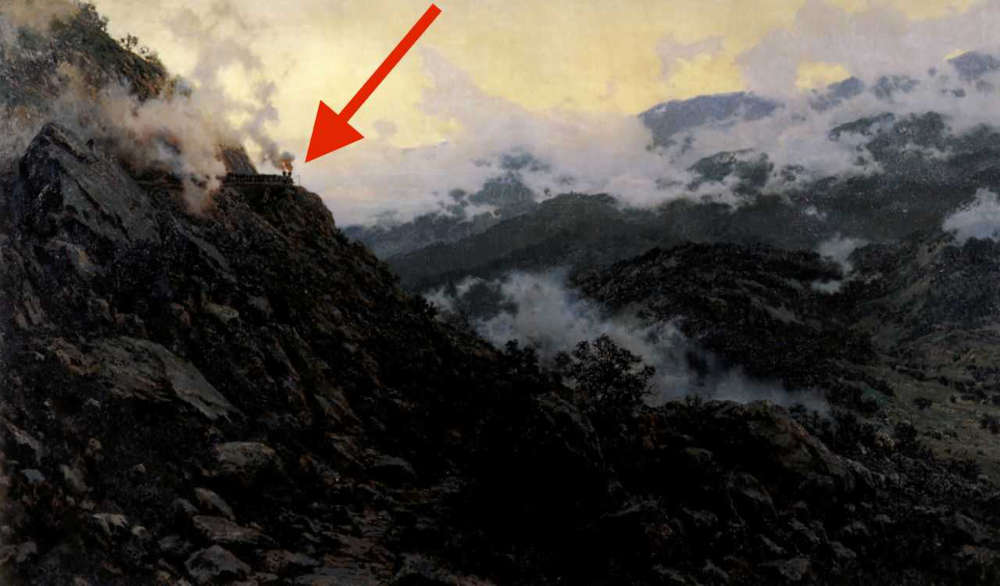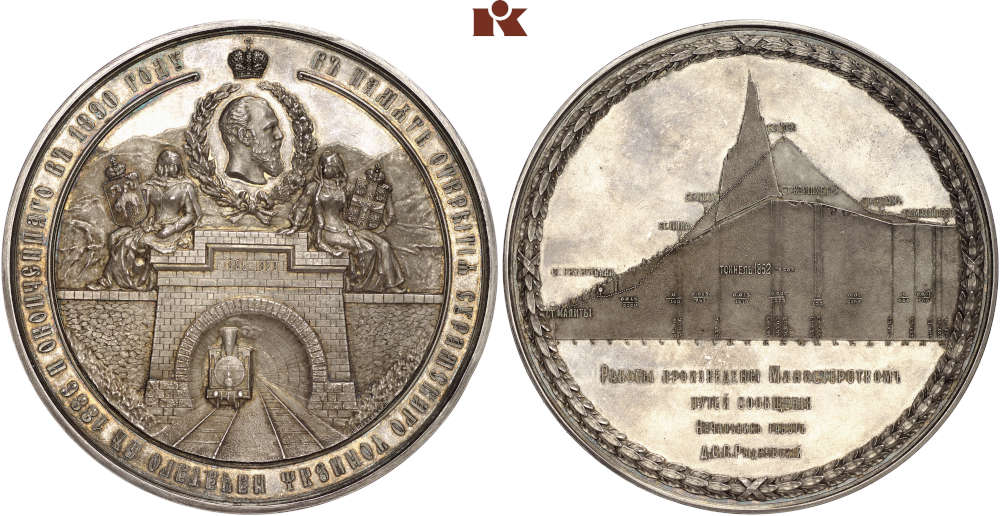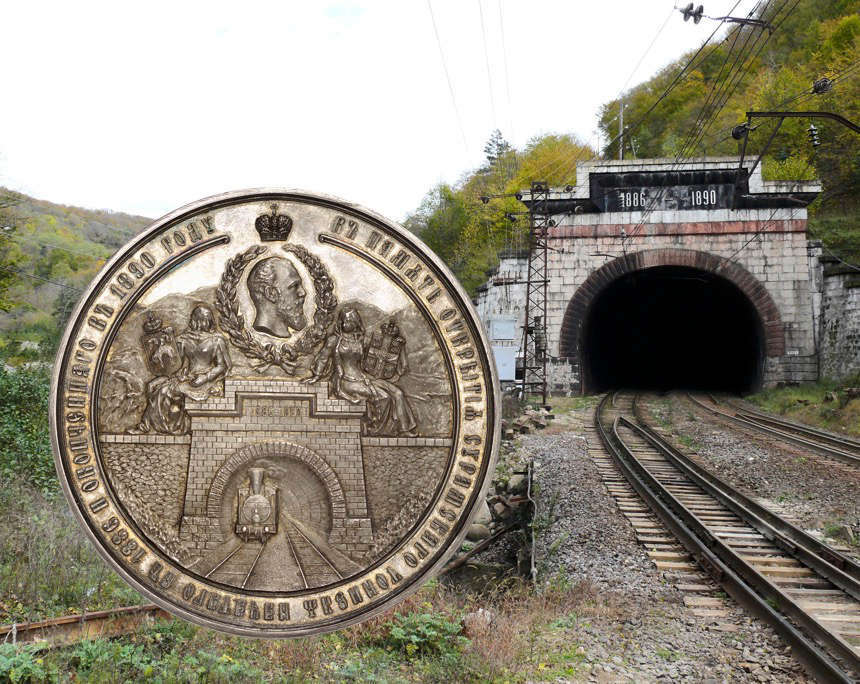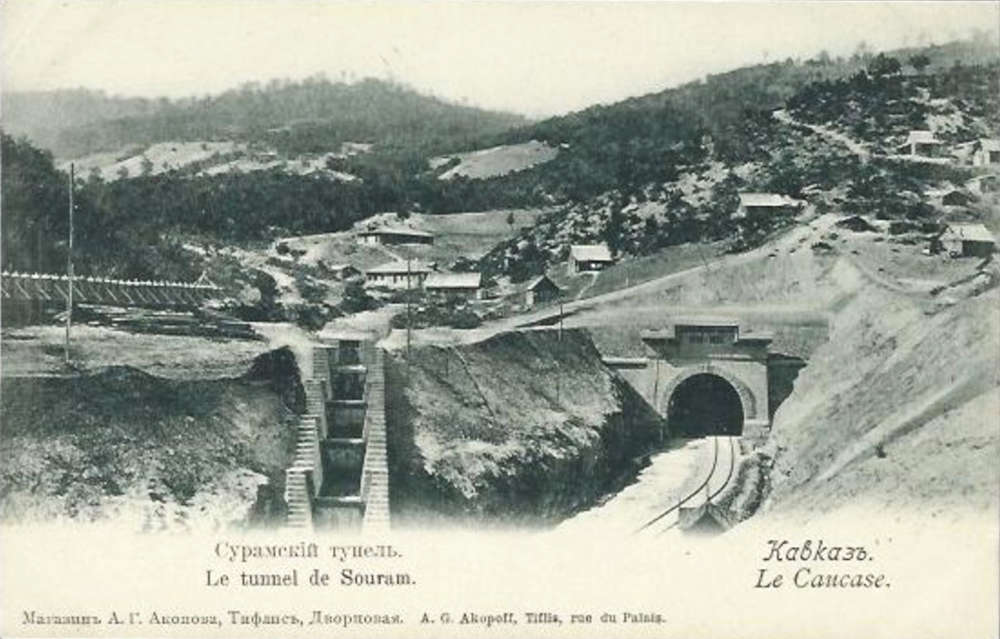For Railroad Fans: The Suram Tunnel
Railroad history is linked to numismatics in many ways. Fascinating large-scale projects were often celebrated with medals and commemorative coins. Our example takes us to Georgia, where a tunnel has reduced the gradient of the Transcaucasus Railway since 1890. A medal that will be offered for auction on 18 June 2024 by Künker commemorates the opening of the Suram Tunnel.
Content
Many collectors are fascinated by coins and medals that focus on the topic of the railroad. And they are quite right to do so: numismatic issues are wonderful objects to illustrate this chapter of the history of technology. A great example for this is an extremely rare 1890 medal that commemorates a masterpiece of engineering: the tunnel of about 2.5 miles underneath the Suram Pass, connecting West and East Georgia.

The old railroad line over the Suram Pass; the red arrow points at the train that makes its treacherous way through the mountains. Oil painting by Alexander Kisseljow from 1891. Today at the Tretjakow Galerie.
Baku and the Connection Between the Caspian Sea and the Black Sea
With the Treaty of Turkmenchay in 1828, Baku became part of Russia. In 1837, the first oil refinery was set up there; and starting in 1872, crude oil was exploited industrially after the Russian Empire had auctioned off the rights to investors. Among the successful bidders were well-known industrial dynasties such as the Rothschild and Nobel families.
A prerequisite for the high hammer prices achieved in this auction was to make Baku accessible by rail. After all, even the most productive oil well was of no use if people and materials could not reach it within a reasonable time. Therefore, the Transcaucasus Railway was set up in the very same year of 1872, connecting the port city of Batumi on the Black Sea with the oil fields of Baku on the Caspian Sea. All the trains on the line had to cross the Suram Pass. It had gradients of up to 46‰ and curve radii of only about 330 feet. For this reason, the Fairlie articulated locomotives of the F series developed for the Semmerling Railroad in Austria were used.
Thanks to oil production, Baku experienced a huge boom and incredible population growth. The population of Baku grew faster than that of London, Paris or New York! This meant that a more frequent rail service was soon needed to transport all the necessary consumer goods to Baku.

Silver medal commemorating the opening of the Suram Tunnel in 1890 by L. Steinman. Extremely rare. Extremely fine to FDC. Estimate: 15,000 euros. From Künker auction 408 (18-19 May 2024), No. 234.
The Medal Commemorating the Opening of the Suram Tunnel
A medal commemorating the opening of the new tunnel under the Suram Pass on 16 September 1890 celebrates the solution to this logistical problem. Its obverse shows the entrance to the railroad tunnel in a mountainous landscape, with a train emerging from the tunnel. The years of construction, 1886 to 1890, are engraved on the portal above. Two young women in traditional clothing with the coats of arms of their provinces are enthroned above the entrance: Kutaisi on the left and Tbilisi on the right. Between them is a portrait of the then reigning Tsar Alexander III in an oak and laurel wreath, the crown above him. The translation of the circumscription reads: Commemorating the breakthrough of the Suram Tunnel, begun in 1886 and completed in 1890. The signature of die cutter L. Steinman can be read in very small letters at the bottom right, next to the railroad line.
Even more exciting for railroad enthusiasts is the depiction on the reverse, which shows the schematic route of the old and the new lines. The names of the former train stations are also mentioned – CT being the abbreviation for station – Mality, Bezhetubani, Tsina, Tsipa, Pona, Suram, Michailowo (now Kashuri). The stations of Tsipa, Pona and Suram were no longer served by the new line. Instead, after passing through the tunnel, the train stopped at Kwischheti and rejoined the old line at Michailowo.
The circumscription in the exergue (given as a translation) names the authority that was responsible for the tunnel: The construction work was carried out by the Ministry of Transportation. Construction Manager D. S. S. Rydziewski.
The Suram Tunnel: A Masterpiece of Engineering
7,258,775 rubles – this was the initial cost estimate for the tunnel of 2.74 miles that was to improve the railroad line. The project was approved and in 1886 the final route, slightly shorter at 2.48 miles, was determined so that the construction work could begin.
First of all, workers had to be recruited. After all, there were not enough people living in the sparsely populated mountain region. A small proportion of the nearly 2,000 workers came from Germany, Switzerland and Italy, where the construction of the transalpine railroad system had produced a whole generation of highly specialized technicians. Bricklayers, stonemasons, lumberjacks, mechanics, and laborers came from the interior of Russia, Persia, Turkey and Greece. Contemporary accounts describe the language problems that arose within this diverse team.
The first step was excavation work, which was carried out from the west from 6 June 1887, and from the east from 15 January 1888. The different dates can be explained by the fact that the western team was to dig 1.9 miles, while the eastern team was “only” supposed to excavate 0.58 miles. After some initial manual work, hydraulic rotary drills developed by the German engineer Alfred Brandt were used. At the time, these were state-of-the-art machines: Their inventor had first presented them at the Vienna World Exposition in 1873. He was met with great skepticism by the public, but the performance of his machines spoke for itself. The tunnel was completely excavated as early as on 12 October 1888 at 7 a.m. When both teams met, there was only a slight deviation of 1.7″ vertically and 5″ horizontally, which was considered an outstanding achievement at the time.
However, the tunnel was too small. Therefore, a team of miners began to manually enlarge the tunnel to the desired size. The tunnel was then lined with granite and sandstone.
The work in the tunnel was done around the clock, in three shifts of eight hours or two shifts of twelve hours, depending on the complexity of the work.
Here are some more numbers: the construction of the tunnel required 163.8 tons of dynamite, 699,937 cubic feet of wood, 5,144,711 cubic feet of stone, 1,389,915 cubic feet of cement and 1,371,904 cubic feet of sand. A total of 13,719,218 cubic feet of dirt was removed from the tunnel.
When the Suram Tunnel was inaugurated on 16 September 1890 in the presence of the Tsarist Minister of Railroads Adolf Yakovlevich Gubbenet, the total cost was 5,224,996 rubles, much less than originally estimated.
Twice As Many Trains Per Day Thanks to the Suram Tunnel
The tunnel reduced the maximum gradient of the line to 28‰, and the minimum curve radius was increased to 492 feet. This bought time to increase train frequency. The Suram Tunnel nearly doubled the number of daily trains between east and west Georgia.
With modern locomotives, up to 50 pairs of trains now travel the route every day. Only at the beginning of this century did this become too few: since 2011, a new line has been under construction to replace the Suram Tunnel.









